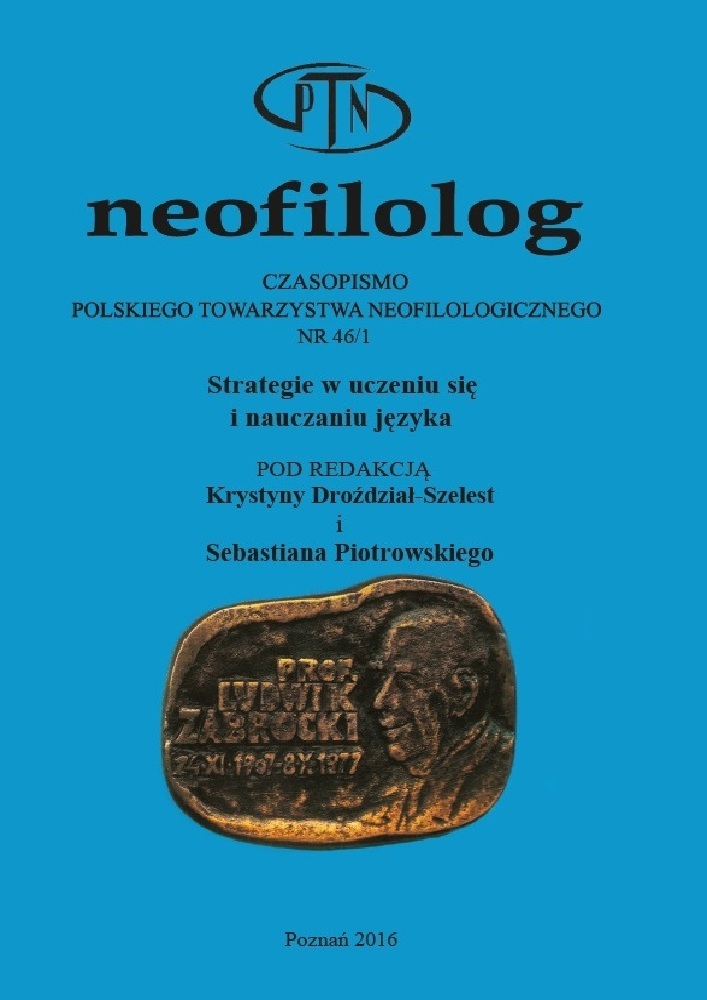Abstrakt
Language researchers have long been aware that anxiety can be associated with the language learning process and negatively correlate with academic achievement, motivation and successful oral performance. Foreign language anxiety was first defined as a negative feeling associated with a language classroom and resulting from a fear of negative evaluation, tests and communication apprehension (Horwitz and Young, 1991). Some learners also reported that they experienced language anxiety in out-of-class oral performance, that it negatively affected their feeling of competence, and beliefs about their successful language acquisition, and also triggered physiological and cognitive responses. The research aimed at identifying sources of language anxiety and its manifestations in adult EFL learners in out-of-class settings, and a set of six strategies was proposed to help learners mitigate the feeling of foreign language anxiety.
Bibliografia
Arnold, J. 2005. “Visualization: language learning with the mind’s eye”. (in) Affect in Language Learning. (ed. Arnold, J.). New York: Cambridge University Press: 260-278.
Cohen, A., L. Manion and Morrison, K. 2007. Research Methods in Education. London: Routledge.
Crookall, D. and Oxford, R. 1991. “Dealing with anxiety: Some practical activities for language learners and teacher trainees”. (in) Language Anxiety: From Theory and Research to Classroom Implications. (eds. Horwitz, E.K. and Young, D.J.). Upper Saddle River: Prentice Hall: 141-150.
Daly, J. 1991. “Understanding communication apprehension: An introduction for lan-guage educators”. (in) Language Anxiety: From Theory and Research to Class-room Implications. (eds. Horwitz, E.K. and Young, D.J.). Upper Saddle River: Prentice Hall: 3-13.
Dornyei, Z. 2005. The Psychology of the Language Learner: Individual Differences in Second Language Acquisition. Mahwah, New Jersey: LEA.
Horwitz, E.K. and Young, D.J. (eds.). 1991. Language Anxiety: From Theory and Re-search to Classroom Implications. Upper Saddle River: Prentice Hall.
Kemmis, S. and McTaggart, R. (eds.). 1988. The Action Research Planner. Geelong: Dea-kin University Press.
MacIntyre, P.D. and Gardner, R.C. 1991. “Language Anxiety: Its relationship to other anxieties and to processing in native and second languages”. Language Learn-ing, 41: 513-534.
MacIntyre, P.D. and Gardner, R.C. 1994. ”The subtle effects of language anxiety on cog-nitive processing in the second language”. Language Learning, 44: 283-305.
MacIntyre, P.D. 1995. “How does anxiety affect second language learning? A reply to Sparks and Ganschow”. The Modern Language Journal, 79: 90-99.
MacIntyre, P.D. 1999. “Language anxiety: A review of the research for language teach-ers”. (in) Affect in Foreign-Language and Second Language Learning: A Practi-cal Guide to Creating a Low-Anxiety Classroom Atmosphere. (ed. Young, D.J.). Boston: McGraw-Hill College: 24-45.
Mejias, H., Applbaum, R.L., Applbaum, S.J. and Trotter II, R.T. 1991. “Oral- communica-tion apprehension and Hispanics: An exploration of oral communication appre-hension among Mexican American students in Texas”. (in) Language Anxiety: From Theory and Research to Classroom Implications. (eds. Horwitz, E.K. and Young, D.J.). Upper Saddle River: Prentice Hall: 87-97.
Morena, K. 2015. “Foreign language anxiety and adult EFL learners: Sources, effects, and what can be done about it”. (in) 10th IPB Erasmus Week Teaching Cross-roads. (eds. Silva, E., Pais, C. and Pais, L.S.). Portugal: Instituto Politécnico da Bra-gança: 57-71.
Ohata, K. 2005. “Potential sources of anxiety for Japanese learners of English: Prelimi-nary case interviews with five Japanese college students in the USA”. TESL-EJ Teaching English as a Second or Foreign Language, 9. http://www.tesl-ej.org/ej35/a3.pdf DW 12.05.2015.
Onwuegbuzie, A.J., Bailey, P. and Daley, C.E. 1997. “Foreign language anxiety among college students”. Paper presented at the Annual Meeting of the Mid-South Ed-ucational Research Association. Memphis, TN. http://eric.ed.gov/?id=ED415713 DW 12.05.2015.
Piechurska-Kuciel, E. 2008. Language Anxiety in Secondary Grammar School Students. Opole: Wydawnictwo Uniwersytetu Opolskiego.
Price, M. L. 1991. “The subjective experience of foreign language anxiety: interviews with highly anxious students”. (in) Language Anxiety: From Theory and Re-search to Classroom Implications. (eds. Horwitz, E.K. and Young, D.J.). Upper Saddle River: Prentice Hall: 101-108.
Rogers, A. 2008. Teaching Adults. Berkshire: Open University Press: McGraw-Hill Educa-tion.
Rogers, J. 2007. Adults Learning. Berkshire: Open University Press: McGraw-Hill Educa-tion.
Sarason, I. G. 1988. “Anxiety, self-preoccupation and attention”. Anxiety Research, 1: 3-7.
Seligman, M.E.P., Walker, E.F. and Rosenhan, D.L. 2001. Abnormal Psychology. New York: W.W. Norton and Company.
Scovel, T. 1991. “The effect of affect on foreign language learning: A review of the anxi-ety literature”. (in) Language Anxiety: From Theory and Research to Classroom Implications. (eds. Horwitz, E.K. and Young, D.J.). Upper Saddle River: Prentice Hall: 15-23.
Spielberger, C.D. 1972. Anxiety: Current Trends in Theory and Research. New York: Academic Press.
Spielberger, C.D. 1983. Manual for the State –Trait Anxiety Inventory (STAI –Form Y). Palo Alto, CA: Consulting Psychologists Press.
Studenska, A. 2007. “Foreign language anxiety inventory.” The New Educational Re-view, 11: 241-259.
Turula, A. 2002. “Language anxiety and classroom dynamics: A study of adult learners”. English Teaching Forum, 40: 28-37. http://americanenglish.state.gov/files/ae/ resource_files/02-40-2-g.pdf. DW 22.03.2015.
Vasa, R. and Pine, D.S. 2004. “Neurobiology in anxiety disorder in children and adoles-cents”. (in) Anxiety Disorders in Children and Adolescents. (eds. Morris, T.R. and March, J.S.). New York: Guilford Press, 98-121.
Von Worde, R. 2003. “Students’ perspectives on foreign language anxiety”. http://files. eric.ed.gov/fulltext/EJ876838.pdf. DW 12.05.2012.
Wine, J. 1971. “Test anxiety and direction of attention”. Psychological Bulletin, 76: 92-104.
Woodrow, L. 2006. “Anxiety and speaking English as a second language”. Regional Language Centre Journal, 37: 308-328.
Young, D.J. 1991. “The relationship between anxiety and foreign language oral profi-ciency ratings”. (in) Language Anxiety: From Theory and Research to Classroom Implications. (eds. Horwitz, E.K. and Young, D.J.). Upper Saddle River: Prentice Hall: 57-63.
Licencja
Prawa autorskie (c) 2018 Katarzyna Morena

Utwór dostępny jest na licencji Creative Commons Uznanie autorstwa – Bez utworów zależnych 4.0 Międzynarodowe.
Przedstawiany utwór (artykuł) upubliczniany jest na podstawie umowy z autorem i na licencji Creative Commons Attribution-NoDerivatives 4.0 International (CC BY-ND 4.0).
Użytkownicy mają obowiązek podania wraz z rozpowszechnionym utworem, informacji o autorstwie, tytule, źródle (odnośniki do oryginalnego utworu, DOI) oraz samej licencji;
- bez tworzenia utworów zależnych,
- utwór musi być zachowany w oryginalnej postaci.
Uniwersytet im. Adama Mickiewicza w Poznaniu zachowuje prawo do czasopisma jako całości (układ, forma graficzna, tytuł, projekt okładki, logo itp.).
